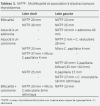NIFTP diagnostic and therapeutic approach
- PMID: 40096732
- PMCID: PMC12034351
- DOI: 10.62438/tunismed.v103i2.4918
NIFTP diagnostic and therapeutic approach
Abstract
Background: Non-invasive follicular thyroid neoplasms with papillary-like nuclear features (NIFTP) still spark controversy regarding histological diagnostic criteria and therapeutic management.
Aim: To elucidate the clinicopathological characteristics of NIFTP tumors and discuss their therapeutic management.
Methods: A retrospective study including 23 patients (26 nodules) operated on and followed up for NIFTP tumors according to the 2017 WHO classification over a 5-year period (January 2016-December 2020). The 2017 EUTIRADS classification was used for ultrasound nodule characterization. Fine-needle aspiration cytology was reported according to the 2017 Bethesda system.
Results: All patients were female, with a mean age of 47 years [19-71]. The average consultation delay was 9 months [2 months-7 years]. Thyroid nodules were incidentally discovered in 6 cases (26%). Examination revealed a solitary thyroid nodule in 20 cases. Nodules were classified as EUTIRADS III or IV in 82%. Fine-needle aspiration cytology, performed in 61% of cases, showed Bethesda III in 64% and IV in 14%. Total thyroidectomy was performed in 74%. Three cases of bifocal NIFTP were identified. Association with thyroid carcinoma was noted in 7 cases. No locoregional or distant recurrence was reported during a mean follow-up of 3 and a half years.
Conclusion: Recent revisions of NIFTP morphological criteria underscore the importance of strict adherence to inclusion and exclusion histo-morphological criteria.
Introduction: Les tumeurs thyroïdiennes folliculaires non invasives avec noyaux de type papillaire «NIFTP» suscitent encore beaucoup de controverses concernant les critères de diagnostic histologiques et la prise en charge thérapeutique. Objectif: Etayer les spécificités clinicopathologiques des tumeurs NIFTP et discuter leur prise en charge thérapeutique. Méthodes: Etude rétrospective incluant 23 patients (26 nodules) opérés et suivis pour une tumeur NIFTP selon la classification de l’OMS 2017 sur une période de 5 ans (janvier 2016-décembre 2020). La classification EUTIRADS 2017 a été utilisée pour la caractérisation des nodules à l’échographie. La cytoponction a été rapportée selon le système BETHESDA 2017. Résultats: Tous nos patients étaient de sexe féminin. L’âge moyen était de 47 ans [19-71]. Le délai moyen de consultation était de 9 mois [2mois–7ans]. Le nodule thyroïdien était de découverte fortuite dans 6cas (26%). L’examen avait révélé la présence d’un nodule isolé de la thyroïde dans 20 cas. Les nodules étaient classés EUITRADS III ou IV dans 82%. La cytoponction, pratiquée dans 61% des cas, était classée en Bethesda III dans 64% et IV dans 14%. Une thyroïdectomie totale a été pratiquée dans 74%. On a recensé 3 cas de NIFTP bifocal. L’association à un carcinome de la thyroïde était notée dans 7 cas. Aucune récidive locorégionale ou à distance n’a été rapportée durant un suivi moyen de 3 ans et demi. Conclusion: Les révisions récentes des critères morphologiques du NIFTP incitent à une adhésion stricte aux critères histo-morphologiques d’inclusion et d’exclusion.
Keywords: NIFTP; Thyroid tumor; fine needle aspiration; surgery; ultrasound.
References
-
- Bychkov A, Keelawat S, Agarwal S, Jain D, Jung CK, Hong S. Impact of non-invasive follicular thyroid neoplasm with papillary-like nuclear features on the Bethesda system for reporting thyroid cytopathology: a multi-institutional study in five Asian countries. Pathology (Phila) 2018;50(4):411–417. - PubMed
Publication types
MeSH terms
LinkOut - more resources
Full Text Sources
Medical



